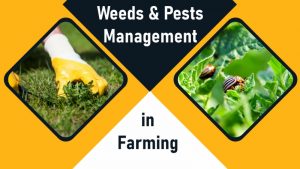Learn more about how good animal husbandry practices can be a good thing for a farm. Livestock management practices contribute to the health of animals when adopted and followed correctly, which in turn promotes productivity and the sustainability of a farm as a business. Nutrition based on high-quality, well-balanced formulas, herd disease prevention through vaccination programs and the controlled, judicious use of antibiotics and other drugs, as well as the establishment of strict biosecurity protocols, all contribute to a low risk of occurrence and spread of diseases in the herd, which in turn ensures its productivity. In addition, waste management, record formalization as well as training and others make the farmer, so use rare ads to allow him to make decisions given the tools he needs to stand and excel in farming, hence profitability in farming
Importance and Preventive Measures in Animal Husbandry
Animal husbandry is vital to our society as it ensures food security, economic survival, and environmental preservation. Below are some of the critical points concerning the significance and preventive measures of animal husbandry:
Importance of Animal Husbandry
- Food Production: the field makes a notable contribution to the production of our food, including meat, milk, other dairy products, eggs, and other animal products.
- Economic Contribution: Animal husbandry plays a crucial role in most of the economies in that it is the livelihood of most rural communities. Livestock contributed to the majority of household incomes via farming or livestock keeping, animal product processing, and marketing.
- Nutritional Value: Animal products provide suitable nutrients for the body, including proteins, vitamins, and minerals, which are vital for the body’s energy and repair.
- Livestock Diversity: Maintaining multiple breeds of livestock and having many other species will help conserve livestock genetics.
- Sustainable Agriculture: Integrating crops and animal production is the foundation of nutritious recycling and soil fertility is the basic foundation for sustainable agriculture.
Preventive Measures in Animal Husbandry
Restricted access to arrangements to disinfect between and around a wide quarantine and within the facilities prevents other infections on the animals. The animal is supposed to be vaccinated regularly to stop worrying about getting an infection. A balanced nutritional diet may increase the fruit’s productivity and wellness. It may well balance eating habits to maintain the physical shape.
The area of the animal is supposed to be taken on routine antigen notices with the correct use of the medication collection to treat. Mass of the crowd is supposed treatment, and the disease occurrence is well-known and quickly withdraws. Arrange the waste to maintain hygiene around the house and gather veterinary medicinal products. Training and education about the management of monitoring intervention persons are supposed to ensure the performance of physical control of the attack of diseases.
The animal record acts as the record the client is supposed to pay for the vaccine to plus your net and a death record of the milk production record. By taking these measures, animal husbandry can foster sustainable agriculture and ensure the safety of livestock and consumers.
How does proper nutrition contribute to the overall well-being of animals?
Appropriate nutrition is essential for the maintenance and productivity of animals raised in animal husbandry. In animal agriculture, nutrients are very important and summarised below:
- Feeding strategies: Practicing animal species, lactating stages, and feed strategies to supplement the required nutrient consumption can enhance the rate of growth.
- Balanced diets: Provide animals with nutritionally balanced and biologically active diets, which are subtle in terms of protein, vitamins, and minerals, and are high in the metabolic body to maintain metabolic processes, immunity, and breeding potential.
- Sufficient nutrition: the farmer does not want to sell poorly fed animals as they will not have a good body condition, or difficulty of gaining weight and muscle mass, and thus, will put the animal at a much lower price than a similar well-fed animal.
- Reproduction: breeding animals on a nutrient-dense diet will lose fewer pregnancies, improved impregnation rates, and stronger offspring.
- Milk Production: Producing more milk and healthy animals is the end-all-be-all be-all objective for any animal farm.
- Disease: A well-fed animal has a more resilient and healthier immune system. This helps your immune system get rid of diseases. Farmers will save their time and money as they do not have to go and look for a veterinarian researcher.
- Longevity and sustainability: By feeding the perfect diet throughout the life of an animal, farmers are able to prolong its productive life and reduce incidences of illness – improving their overall farm performance.
Importance of selective breeding for desirable traits
The following are the selected traits enhanced by selective breeding: Animals that farmers breed can have the following enhanced traits: Growth rate, milk production, meat quality, disease resistance, and temperament, among others. Selective breeding then allows farmers to develop genetic lines containing the most wanted traits. Trait combination enhances more yields in terms of more meat, milk, or fibres and eggs, which is for commercial dairy and beef farming.
The population of animals contains a variety of the desired traits of farmers or what they produce. Selective breeding removes the undesirable factors or traits. The selection of various desirable traits leads to economic benefits. Selective breeding allows for selection which alters the feeding system of the sought-after animals; that is, the farmer chooses the animals that consume little feed but produce a lot. Farmers choose what they want, and then they breed.
Farmers select the best traits for a particular product, for example: to produce quality meat that tastes good, has a specific shape, and has enough energy sources. Selective breeding can generate animals that can switch under the area undoing the ecosystem’s ability to it may breed in due course less time has been spent on the management of today’s farm. Through Trait selection for other the selected traits, it may render that the benefit realized in the production more valuable in the future than now.
Legal and regulatory aspects of animal husbandry
The Indian legal and regulatory environment with animal husbandry will thus be a delicate schism between various factors, including animal and environmental friendliness and economic reality. Below are the simplified premises to consider.
Central Laws:
1. Prevention of Cruelty to Animals Act, 1960 This law is core to most of the laws about animals. It broadly criminalizes giving animals pain or suffering unless it is otherwise inevitable.
2. Indian Penal Code, 1860 The two sections, namely 428 and 429 IPC, cover quite several offences against animals, such as killing, maiming, etc.
State-Level Regulations:
Most States have their constitutions with a central theme on Cattle protection and cow slaughter. Other consideration:
1. International Several international conventions on animal protection also feature in the Indian legal systems, although they are non-binding.
2. Food safety Structural food safety is also a cornerstone of ensuring animal products for human consumption do not bring harm to consumers. This includes antibiotic usage, farm sanitation, and slaughter, among others.
Overall Focus:
The Indian legal framework primarily focuses on:
- Animal Welfare: Priority is given to preventing unnecessary suffering.
- Public Health: Ensuring safe animal products is a key concern.
- Economic Balance: Regulations strive to support the livelihoods of those in animal husbandry while maintaining practicality and sustainability.
Training and Education for Farmers
Training and education are essential to Indian farmers who engage in animal husbandry, as they advocate for continuous learning and knowledge acquisition that facilitates farmers making a positive impact on the animal husbandry industry. The need for continued learning in animal husbandry is critical because livestock farming has been rapidly changing with technology, market dynamics have spearheaded drastic changes, and best practices have been evolving to newer levels.
Learning enables the farmer to have the latest information and trends. Continued learning in animal husbandry shares various benefits to the farmer; it enhances the farmer’s knowledge of animal behaviour, health, and nutrition. This in return, ensures the farmer’s animals constantly get professional services, absent farmers engage in guesswork and assumptions, leading the animals to a slow, painful death. Proper knowledge enables farmers to detect early signs of diseases to prevent further spread and take preventive treatment measures, as well as make correct and informed decisions on the health and nutrition of their animals.
Training and education facilitate the use of modern agriculture and animal husbandry technologies. Farmers get access to precision farming and agribusiness through training, which increases efficiency and profitability. Concerning the environment, the sustainability of the farming course is to detect and conserve resources. Farmers’ education is a source of innovative ideas for implementation. decades of farmers’ creation research and innovative projects to address challenges identified within the course, this innovation course impacts the practice of animal husbandry, product, and market competitiveness improvement.
Additionally, farmers who have gone through training are better suited to meet legal requirements set by the industry. This allows the farmers to maintain a high food chain and take risks on unfair competition out of the business. Agriculture to produce in industry, this for the consumption of the much available market. Farmers further contribute to national economic growth through mainstream industrial manufacturing and agribusiness processing.
Conclusion
Therefore, conclusively, training and education are critical elements that define the efficiency and sustainability of animal husbandry in India. As a result of information acquisition, the farmers are knowledgeable about animal behaviour, diet, health, and technology, among others. Thus, the information acquired is responsible for promoting decision-making, controlling diseases, maintaining quality livestock, and increasing productivity. Additionally, farmers help advance innovation, adherence to legal and regulatory frameworks, and environmental conservation, among others, due to the knowledge they acquire. Therefore, investing in training and education will result in a responsible and lucrative business, resulting in increased growth due to the expanding market demand. Educated farmers will, therefore, account for a more resilient undertaking that will benefit not only them as individuals but the entire society as well.





